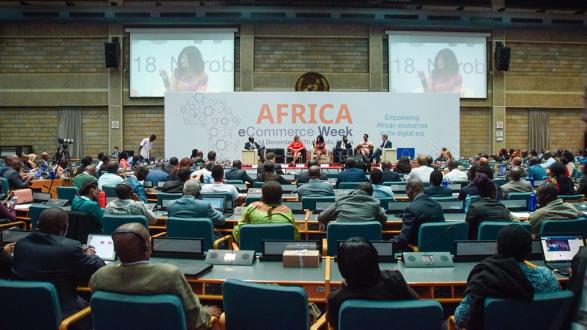The African Continental Free Trade Area Agreement (AfCFTA) constitutes an excellent strategy to develop Africa’s economy through its manufacturing sector.
The manufacturing sector, which is one of the key drivers of economic growth through the accumulation of capital and labor, accounts for about 10 percent of GDP in Africa. Also, more than 60 percent of the value of manufacturing production in Africa concentrates on four countries only: Egypt, Nigeria, South Africa, and Morocco. The AfCFTA will boost the continent’s manufacturing sector by facilitating access to new markets for small and medium-sized enterprises (SMEs), increasing economies of scale, and facilitating exports diversification.
Firstly, small and medium-sized enterprises (SMEs) will have access to a more expanded market. SMEs represent about 80 percent of Africa’s businesses. Nevertheless, they struggle to grow because of multiple barriers that limit their capacity to compete on the market and trade with neighboring countries. The AfCFTA will make SMEs in the manufacturing sector, such as fruit juice businesses more competitive on the market.
The AfCFTA will make Africa the largest free trade area in the world, with more than 1.2 billion consumers and a GDP of about $3.4 trillion.
Intra-regional trade in Africa represents only 16 percent, compared to 60 percent of trade outside the continent, according to the African Development Bank. One of the main objectives of the AfCFTA is to “create a single continental market for goods and services, with free movement of business persons and investments.” The AfCFTA will make Africa the largest free trade area in the world, with more than 1.2 billion consumers and a GDP of about $3.4 trillion.
Besides, the AfCFTA is set to increase Africa’s intra-continental trade by 52.3 percent by 2022. SMEs will be able to raise their sales because of their capacity to reach consumers from all over the continent. Also, local SMEs will benefit from partnerships with potential foreign investors who would seek to expand or launch their businesses on the continent. For example, the Nigerian government has imposed some restrictions on imported manufactured goods to drive foreign investors to invest in manufactured products in Nigeria or to partner with local businesses. As a result, the increase in sales and the transfer of skills and technology through SMEs’ partnerships with potential foreign investors would develop the manufacturing sector in Africa.
Secondly, the AfCFTA will help businesses in the manufacturing sector increase their economies of scale by facilitating the reduction of costs of production because of the ease to acquire and supply production inputs. For example, under the Southern African Customs Union trading agreement, automobile manufacturers in South Africa have reduced their costs of production by importing leather for seats and fabrics from Botswana and Lesotho before they export assembled cars abroad.
Africa heavily depends on its natural resources’ exports. The lack of adequate tools to transform natural resources into value-added manufactured goods hinders exports diversification and hence, growth.
The AfCFTA aims to “enhance competitiveness at the industry and enterprise level through exploiting opportunities for scale production” at the continental level. Thus, the AfCFTA constitutes a mean for businesses to access more production inputs and cheap labor force. For example, Volkswagen Group has implanted its car plants across the continent—South Africa, Nigeria, Kenya, Algeria, and Rwanda—to reduce their production costs and increase their sales. These expansions contribute to local production at lower costs, which will boost the manufacturing sector on the African continent. According to the consulting firm McKinsey, Africa has the capacity to double the size of its manufacturing sector, with an annual output of about $1 trillion by 2025.
Lastly, the AfCFTA will facilitate exports diversification in terms of baskets of goods and transportation of goods. Africa heavily depends on its natural resources’ exports. The lack of adequate tools to transform natural resources into value-added manufactured goods hinders exports diversification and hence, growth. Many African countries have a competitive advantage, especially in the mining industry and the agro-industry, but the limitations in the manufacturing sector hinder them from fully developing a comparative advantage.
For example, Ethiopia, a country whose main agricultural products include cows, sheep, and cattle, exports only 7 percent of live animals, 3 percent of raw leather products, and 3 percent of meat products because of its limited processing capacity. The AfCFTA will facilitate key drivers of exports diversification such as infrastructure and proximity to markets. Chinese investors have invested in building a railroad going from Nairobi to Mombasa (Kenya), with the intent to extend it to Kampala (Uganda) and Kigali (Rwanda).
The AfCFTA constitutes a significant contributor to the development of the manufacturing sector in Africa since it will enhance drivers of the sector’s growth.
On the one hand, countries with a strong manufacturing sector will benefit from the AfCFTA in terms of countries’ large-scale production and diversified exports of value-added manufactured goods. On the other hand, countries with a weak manufacturing sector will benefit from the AfCFTA in terms of gaining increased participation in trade supply chains.
To conclude, it is promising that Africa has unlocked its manufacturing sector’s potential for growth by creating opportunities through reforms and regional integration. The AfCFTA constitutes a significant contributor to the development of the manufacturing sector in Africa since it will enhance drivers of the sector’s growth. Thus, both potential investors and African leaders should not miss this unique opportunity.
____________________
Aurelie Ngo Mambongo is a graduate of the Emerging Leaders Program at the Harvard Kennedy School of Government.
The views and opinions expressed here are those of the author and do not necessarily reflect the official policy or position of the Pacific Council.




